
Syringa is a genus of 12 currently recognized species of flowering woody plants in the olive family or Oleaceae called lilacs. These lilacs are native to woodland and scrub from southeastern Europe to eastern Asia, and widely and commonly cultivated in temperate areas elsewhere.

Allspice, also known as Jamaica pepper, myrtle pepper, pimenta, or pimento, is the dried unripe berry of Pimenta dioica, a midcanopy tree native to the Greater Antilles, southern Mexico, and Central America, now cultivated in many warm parts of the world. The name allspice was coined as early as 1621 by the English, who valued it as a spice that combined the flavours of cinnamon, nutmeg, and clove.

The genus Tamarix is composed of about 50–60 species of flowering plants in the family Tamaricaceae, native to drier areas of Eurasia and Africa. The generic name originated in Latin and may refer to the Tamaris River in Hispania Tarraconensis (Spain).
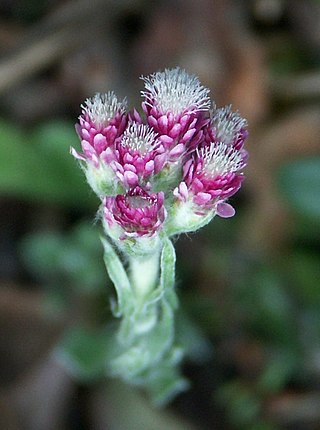
Antennaria dioica is a Eurasian and North American species of flowering plant in the family Asteraceae. It is a perennial herb found in cool northern and mountainous regions of Europe and northern Asia (Russia, Mongolia, Japan, Kazakhstan, China, and also in North America in Alaska only.

Ixora coccinea is a species of flowering plant in the family Rubiaceae. It is a common flowering shrub native to Southern India, Bangladesh, and Sri Lanka. It has become one of the most popular flowering shrubs in South Florida gardens and landscapes. It is the national flower of Suriname. Commercially important medicinal plant, used in ayurveda. All parts including flower, leaves and root are taken for various medicinal preparations for skin disease, Diabetes etc

Pyracantha crenulata, the Nepalese firethorn, Nepal firethorn or Himalayan firethorn, is a species of firethorn. The native range of this shrub species stretches from northern Pakistan to northwestern India and China.

Pakistan's native flora reflects its varied climatic zones, which range from arid and semi-arid to temperate and tropical.

Tamarix ramosissima, commonly known as saltcedarsalt cedar, or tamarisk, is a deciduous arching shrub with reddish stems, feathery, pale green foliage, and characteristic small pink flowers.

Tamarix gallica, the French tamarisk, is a deciduous, herbaceous, twiggy shrub or small tree reaching up to about 5 meters high.

Wrightia tinctoria, Pala indigo plant or dyer's oleander, is a flowering plant species in the genus Wrightia found in India, southeast Asia and Australia. It is found in dry and moist regions in its distribution. Various parts of the plant have been used in traditional medicine, but there is no scientific evidence it is effective or safe for treating any disease.

Tamarix chinensis is a species of tamarisk known by the common names five-stamen tamarisk and Chinese tamarisk or saltcedar. It is native to China and Korea, and it is known in many other parts of the world as an introduced species and sometimes an invasive noxious weed. It easily inhabits moist habitat with saline soils. It may grow as a tree with a single trunk or as a shrub with several spreading erect branches reaching 6 metres or more in maximum height. It has been known to reach 12 metres. It has reddish, brown, or black bark. The small, multibranched twigs are covered in small lance-shaped, scale-like leaves which are no more than about 3 mm long. The inflorescence is a dense raceme of flowers a few cm long. Each fragrant flower has five petals which are usually pink but range from white to red.

Tamarix parviflora is a species of tamarisk known by the common name smallflower tamarisk.
Suaeda fruticosa is a species of flowering plant in the family Amaranthaceae. It is a small shrub, with very variable appearance over its wide range. It is a halophyte, and occurs in arid and semi-arid saltflats, salt marshes and similar habitats.

Ficus auriculata is a type of fig tree, native to subtropical parts of Asia. It is noted for its big and round leaves and edible fruit.
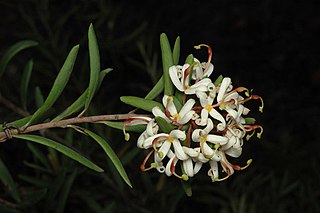
Lomatia polymorpha, commonly known as mountain guitar plant, is a shrub or small tree of the family Proteaceae which is endemic to Tasmania. It is a shrub or small tree with linear leaves, and white, cream-coloured or greenish flowers. It is common throughout its range which is approximately complementary to that of L. tinctoria in Tasmania.
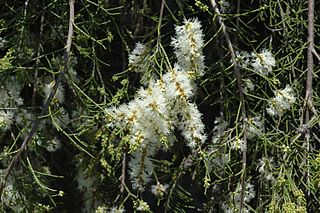
Melaleuca tamariscina, commonly known as bush-house paperbark or tamarix honey-myrtle is a plant in the myrtle family, Myrtaceae and is endemic to central Queensland in Australia. It grows to the height of a small tree with small, scale-like leaves that are pressed against the branches, and has a papery bark and a weeping habit.
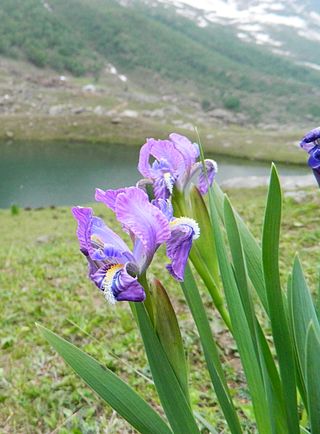
Iris hookeriana is a plant species in the genus Iris, it is also in the subgenus Iris and in the section Pseudoregelia. It is a rhizomatous perennial, from the Himalayan mountains of India and Pakistan. It has long pale green or yellow green leaves, long slender stem and fragrant blue, purple or lilac flowers, that are mottled with a darker colour. It is cultivated as an ornamental plant in temperate regions.

Tamarix nilotica, the Nile tamarisk is a species of shrub or small tree in the tamarisk family. It is found in arid parts of North Africa and the Middle East, particularly areas with high salinity. It forms part of the dune stabilisation process.

Tamarix usneoides, locally known as wild tamarisk, is a twiggy shrub or small evergreen tree that grows in saline habitats, semi-deserts and karroid areas in southern Africa, ranging from Angola through Namibia to the Cape Provinces of South Africa. It has a short trunk, thin branches usually growing from ground level, tiny scale-like leaves and spikes of creamy-white flowers.
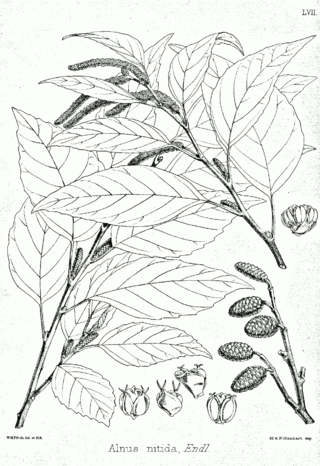
Alnus nitida, the west Himalayan alder, is a species in the genus Alnus, native to Pakistan, the western Himalayas, and Nepal. It is a tree reaching 20 to 25 m, preferring to live along the banks of rivers. It is used locally for timber and firewood, and as a street tree. The bark is used in some places for tanning and dyeing purposes. It grows well in heavy, clay soils and tolerates infertile soils. The leaves are thin, oval to ovate, 3-6 inches long and 2-3 inches wide. Female flowers appear first, followed by male catkinss in September to October, which may be up to 19 cm long. The fruits are woody cones, typically 2.5-3.5 cm long.



















